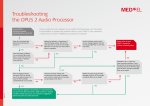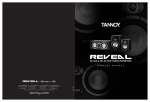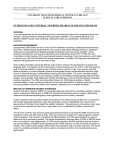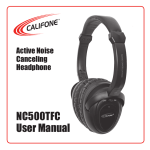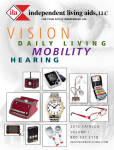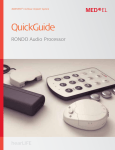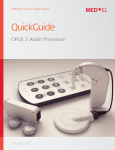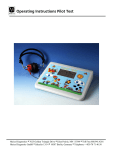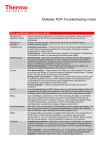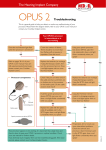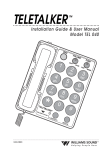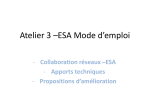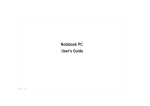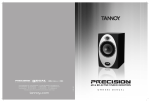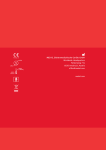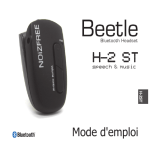Download Getting Connected
Transcript
USING ASSISTIVE LISTENING DEVICES Getting Connected 1 Bringing Sound Even Closer to You Cochlear implant (CI) technology has opened up a whole new world of sound and improved quality of life for many people. But sometimes your own personal listening experience can be even better with help from an Assistive Listening Device (ALD). An ALD can help you hear and enjoy a concert or other performance, catch every word of a teacher’s lesson or seminar, even engage in a quieter, more personal hearing experience when you’re watching TV or listening to your iPod. ALDs are designed to bring sound closer to the listener, effectively overcoming certain factors that compromise hearing, such as background noise, distance from the speaker or poor room acoustics. They can be used with or without CIs or hearing aids to make hearing easier in theaters, classrooms, conference rooms, places of worship, museums, theme parks, and even your own home. By reducing stress and fatigue, ALDs can help you relax and focus on life’s best experiences, instead of sound distractions. The OPUS 2 is loaded with features to maximize your experience with 2 assistive technology. Infrared Systems are similar to FM systems but use a non-visible light beam from a transmitter that sends a signal to a personal receiver. Since infrared signals cannot go through walls, it is commonly used in homes, theaters and conference centers. A headset, telecoil accessory, or direct-connect audio cable is used with the personal receiver to transmit sound to the audio processor(s). Induction Loop Systems are most common in large group areas, but can be used in the home (i.e., rooms with a television). A thin wire is placed around the listening area and is connected to a special amplifier where sound signals are circulated through the loop wire. The sound is sent directly to the audio processor(s) by simply activating the telecoil on the processor(s). What are examples of ALDs? Frequency Modulation (FM) Systems are like miniature radio stations operating on special frequencies assigned by the Federal Communications Commission. The FM system consists of a transmitter used by the speaker and a receiver used by the listener. The receiver transmits the sound to the audio processor either through direct audio input or through a telecoil accessory (such as a neckloop or silhouette). Small personal FM systems are useful in a variety of situations such as a classroom lecture, in a restaurant or a sales meeting. Larger FM systems are often used in theaters, places of worship, museums, public meeting places, corporate conference rooms and convention centers. 4 Bluetooth is a low-power, short range technology that wirelessly connects cell phones (or MP3 devices, PDAs, computers, etc.) to a compatible receiver. Some receivers can be connected directly to the audio processor and others are used with a headset or telecoil accessory. It’s so easy to use my neckloop with the OPUS 2. At company presentations, the speaker sounds as if he is standing right next to me! ANNE M. 5 Using the OPUS 2 with Assistive Listening Devices The OPUS 2 features an integrated state-ofthe-art telecoil and an FM Battery Pack Cover for completely wireless access to a wide variety of telephones, public sound systems, MP3 players and direct-link systems – such as FM and Bluetooth® systems. You can access induction loop technology at the simple touch of a button, and a standard input jack means you can connect the same FM receivers used with many hearing aids. OPUS 2 processor and FineTuner™ remote control Whether you want to talk on the phone with family or enjoy a movie with friends – MED-EL keeps you connected. Integrated Telecoil The OPUS 2 has an integrated state-of-the-art telecoil, a miniature receiver that can be used with a wide variety of telephones, public sound systems and induction loop systems. The telecoil is also independent of the four program settings which means that you can use telecoil with ANY program. Standard FM Port The standard input jack on the FM Battery Cover provides you the widest variety of connectivity with different audio devices. The input jack is the same three-pin port that is used with hearing aids – which allows new CI users to preserve their initial investments by continuing to use their personal assistive devices. Universal Audio Cables MED-EL provides three audio cables that work with the majority of audio devices (music players, FM systems, etc): Yellow Mixing Cable (50:50 ratio) Provides sound input from both the microphone (environment) and the connected audio device. Red Non-mixing Cable (90:10 ratio) Provides maximum sound input from the connected audio device withminimal input from the OPUS 2 microphone (environment). Bilateral Cable Connects an audio device to both audio processors and offers stereo sound for bilateral OPUS 2 users. 6 7 Using Telecoil Delivering sound by magnetic induction A telecoil is a special circuit inside the audio processor designed to pick up electromagnetic signals. These magnetic signals – or induction signals – are wirelessly transmitted to the audio processor by using either a neckloop, silhouette, or induction loop system. A neckloop is a wire worn comfortably around the neck that transmits signals to the processor. A silhouette is an ear-level telecoil device that is placed on the ear next to the audio processor. Simply plug the telecoil accessory (neckloop or silhouette) into the audio device or ALD receiver and select “T” or “MT” on the FineTuner. Adjust volume as needed. For Induction Loop Systems, simply position yourself within the listening area and select “T” or “MT” on the FineTuner. Adjust volume as needed. Tip: Electromagnetic technology is susceptible to interference, which can cause some intermittent humming while using a telecoil accessory. Humming usually occurs when the user is positioned near a source of electromagnetic energy (power lines, fluorescent lighting, computers, appliances, electronics, etc.). Simply moving away from the source can remedy interference issues if they occur. 8 &Play Plug Using a third-party telecoil accessory: Insert the telecoil device’s 3.5 mm plug into the headphone jack of the music device. On your FineTuner, press “MT” or “T” to activate telecoil. Place the telecoil accessory around neck (neckloop) or on the ear (earhook). M: Microphone T: Telecoil Only MT: Microphone and Telecoil Together These keys are independent of all other processor settings and can be used with any program selection (1,2,3, or 4), volume, or sensitivity setting. 9 Direct Audio Input With the FM Battery Pack Cover FM receivers - Many FM receivers and direct-link devices with the standard 3-pin connector (e.g., Phonak MicroLink MLxS) can be used with the OPUS 2 FM battery pack cover. Turn the audio processor off, insert the receiver, and turn the processor back on. When the FM system is activated, the audio processor will automatically integrate the sound signal. Audio Cables - Connect the 3-pin connector of the MED-EL Audio Cable (gray end) to the openings at the bottom of the FM battery pack cover. Mind the orientation of the three pins and do not use excessive force when connecting the cable. Connect the audio plug (yellow or red end) to the audio output of the battery-powered device. &Play Plug Using third-party FM receivers: Tip: Direct connections almost always provide a distortion-free, clear listening experience not limited by interference issues that telecoil accessories may sometimes encounter. However, FM systems themselves may be susceptible to interference from the FM signal. Audio cables running from the processor can be somewhat restrictive since this is not a wireless option. Extensive use of audio cables can also slightly decrease processor battery life. (NOTE: Telecoil is not needed when using direct-connect accessories or audio cables.) 10 Replace the Standard Battery Cover with the FM Battery Cover. Carefully insert the mini-receiver into the port at the bottom. Refer to the FM system user manual for options to adjust FM setting if necessary. Using MED-EL’s direct-connect audio cable: Replace the Standard Battery Cover with the FM Battery Cover. Insert the audio cable’s 3-pin plug into the FM Battery Cover port. Insert the audio cable’s 3.5 mm plug into the headphone jack of the music device. 11 & Plug Play Understanding Audio Cables Not all assistive devices are created equal, and it can be somewhat overwhelming with all the various sizes and configurations. Here is some basic information that can help you better understand the differences and make the right choice when selecting an assistive listening accessory. 2.5mm (used with telephones) 3.5mm (standard size for use with MP3 players, PDAs, and assistive listening devices) Using Bluetooth Many Bluetooth accessories for use with hearing devices integrate telecoil technology. These products feature a small receiver that converts the bluetooth signal to a telecoil signal, which is transmitted via neckloop or silhouette. Some newer Bluetooth devices use a direct-connect accessory which can be connected to the 3-pin port of the FM Battery Pack Cover. Mono plug (one ring) Usually found on older model accessories primarily designed for use with FM systems. Stereo plug (two rings) Phone BLUETOOTH DEVICE [ ear-level, neckloop, etc. ] Newer accessory models use stereo plugs to be more compatible with MP3 players, PDAs, phones, and other audio devices. Adapter A variety of inexpensive adapters are available at local electronics stores. These adapters convert stereo to mono plugs or 3.5mm to 2.5mm plugs (and vice-versa). These are useful when you are using accessories (audio cables, neckloops, etc.) that have a different configuration than the receiver you are connecting to. For example, an older FM system may only work with a mono plug – and you have a stereo neckloop jack. Simply use a stereo-to-mono adapter and it should work properly. 12 Have you tried... Noise-Canceling Headphones Technology that filters out unwanted ambient noise can provide a much-improved listening experience for CI users. Headphones can be worn over the audio processor without concern about feedback issues, as is prevalent with hearing aids. iPod is a registered trademark of Apple Computers, Inc. registered in the U.S. and other countries. Bluetooth is a registered trademark of the Bluetooth SIG, Inc Photos courtesy of ClearSounds, Williams Sound, and NOiZFREE. 13 Special considerations for children * It is well documented that children’s language development, speech development, social skills, and academic achievement depend on the ability to hear. Assistive listening systems maximize children’s hearing and learning capabilities. FM systems, because of their flexibility, mobility, and sturdiness, are among Studies have shown that the best results are achieved when an FM system is included early in the amplification fitting process. In fact, audiologists routinely recommend that a child’s hearing device be equipped with “T” (telecoil/ telephone) switches, “M”/”T” (microphone/telecoil) combination switches, and Direct Audio Input (DAI) capability that will allow connection with assistive listening systems. the most common ALDs used with children. FM systems have wide application in educational settings because of the long-recognized benefit that this technology provides in noisy and reverberant child care, preschool, and classroom environments. When you think of where and how your child spends the day, you quickly realize how ALDs provide benefit in noisy play areas or in reverberent, noisy classrooms. 14 *Content on pp 14-17 has been adapted with permission from the Audiology Information Series: Assistive technology. Available from the Web site of the American Speech-Language-Hearing Association: http://www.asha.org/uploadedFiles/aud/InfoSeriesAssistiveTechnology.pdf. What is Signal-to-Noise Ratio? Assistive Listening technology often refers to a specific Signal-to-Noise ratio in product specifications. This is simply measuring (in decibels) how much louder the signal is than the the background noise. For instance, a good signal-to-noise ratio of 20 dB means the signal is 20 decibels louder than any noise or background. The larger the number, the better the signal-to-noise ratio. 15 What FM systems do for children in schools - They allow the child to hear the teacher’s voice at an appropriate and constant intensity level regardless of the distance between the child and the teacher. - They allow the teacher’s voice to be more prominently heard than background noise (toys, papers, chairs scraping, whispering, pencils being sharpened, feet shuffling) even when the background noise is closer to the child than the teacher’s voice. - They allow for self-monitoring of the child’s own voice through the audio processor’s microphone. - They allow for the audio processor’s microphone to be turned off so that the child can concentrate only on the teacher. Other assistive listening systems used in schools While personal FM systems are most commonly used by children with hearing loss, there are amplification systems – called sound field systems – that assist listening for all children in the class. Using FM technology, the teacher speaks into a microphone transmitter and his/ her voice is projected through speakers situated around the classroom. Sound field systems greatly assist in overcoming the problems of distance, background noise, and poor room acoustics that affect listening for all children – with or without hearing loss. Sound field systems have also been found to benefit children with other auditory and learning problems. In addition to helping students with hearing loss, sound field systems have been effective for those with central auditory processing disorders, learning disabilities, developmental delays, attention deficits, language delays, articulation disorders, and those learning English as a second language. Who is qualified to determine if my child needs an ALD? A certified audiologist can assist in the selection, evaluation, fitting and dispensing of an FM system. School districts are required to employ audiologists to manage these issues. Their expertise includes the evaluation, selection, procurement, and monitoring of ALDs used in school. Furthermore, audiologists guide and instruct teachers and students in making the best use of ALDs. For more information on hearing, hearing technology, and intervention, please visit the website of the American Speech-LanguageHearing Association at www.asha.org. 16 17 Additional Tips Requesting ALDs ALDs can usually be obtained at Guest Services, Concierge, or Box Offices at venues that provide them. When asking for an ALD, be sure to ask if they have the receiver boxes – not headsets with earbuds – that use neckloops or have a headphone jack. (You can use your own neckloop or headset if you own one.) Know your rights. Increased availability and usage of FM systems are due in large measure to legislation that mandates access to technology for persons with hearing and other communication disabilities: (1) the Americans with Disabilities Act, (2) the Individuals with Disabilities Education Act (IDEA), and (3) Section 504 of the Rehabilitation Act. Under IDEA, consideration of assistive technology for any child with a disability must take place as part of the development of the Indvidualized Educational Program. Each in some way deals with the issue of “access” to instruction. Of course, for the child with hearing loss, “access” means being able to hear instruction! Look for the ALD symbol at venues or events. This promotes that assistive devices are available. Visual Aids Many venues like museums and theaters can provide scripts of the performance or presentation. It may require advanced notice, so you should consider requesting one several days prior to the event. Reflective (or rear-window) captioning services are offered at venues like theaters or theme parks. A large LED display is mounted on a rear wall that displays caption characters reflected on a small portable plastic panel. Check the movie listings or contact the venue directly for additional information. 18 Purchasing ALDs Purchase a personal telecoil neckloop or silhouette for use when attending events that provide assistive listening technology. Neckloops and silhouettes are available from a variety of online vendors. Some telecoil products are also amplifed and can provide additional volume, if needed. Furthermore, some telecoil accessories include a built-in microphone that works extremely well with telephones. The benefit of having a built-in microphone is that you can use it with many FM systems, MP3 players, and even your telephone. Be sure to look at all the specifications before making your purchase to ensure that it has everything you need. Consider purchasing inexpensive adapters from a local electronics store. (An example is a stereo-to-mono adapter.) Some older ALD systems use mono jacks and may not work with a telecoil or audio cable that uses a stereo plug. Every Step of the Way For additional information about assistive listening devices or help in selecting the right product for you, please contact one of MED-EL‘s in-house audiologists at 1-888-633-3524. 19 MED-EL is committed to enriching the lives of people with hearing loss through innovative, leading-edge technology and medical science. Our goal is to provide a whole new world of hearing and a whole new way of living, never forgetting that people and relationships are at the heart of everything we do. For a list of cochlear implant audiologists by state, visit www.medel.com. Email us at [email protected] or call us toll free at 888-633-3524 for more information. MED-EL Corporation, USA 2511 Old Cornwallis Road | Suite 100 Durham, NC 27713 toll free (888) MEDEL-CI (633-3524) V/TDD phone (919) 572-2222 fax (919) 484-9229 email [email protected] www.medel.com 20 22871 r2.0












